The Arithmetic Logic Unit (ALU) is a core element of a computer processor that performs arithmetic and logic operations on the operands in computer instruction words. We have developed and tested an RSFQ multi-bit ALU constructed with half adder unit ...
http://chineseinput.net/에서 pinyin(병음)방식으로 중국어를 변환할 수 있습니다.
변환된 중국어를 복사하여 사용하시면 됩니다.
- 中文 을 입력하시려면 zhongwen을 입력하시고 space를누르시면됩니다.
- 北京 을 입력하시려면 beijing을 입력하시고 space를 누르시면 됩니다.
https://www.riss.kr/link?id=A100687840
-
저자
김진영 ; 고지훈 ; 강준희 ; Kim, Jin-Young ; Ko, Ji-Hoon ; Kang, Joon-Hee
- 발행기관
- 학술지명
- 권호사항
-
발행연도
2006
-
작성언어
Korean
-
주제어
single ; flux ; quantum ; arithmetic ; logic ; superconductivity ; digital
-
등재정보
구)KCI등재(통합)
-
자료형태
학술저널
- 발행기관 URL
-
수록면
109-113(5쪽)
- 제공처
-
0
상세조회 -
0
다운로드
부가정보
다국어 초록 (Multilingual Abstract)
The Arithmetic Logic Unit (ALU) is a core element of a computer processor that performs arithmetic and logic operations on the operands in computer instruction words. We have developed and tested an RSFQ multi-bit ALU constructed with half adder unit cells. To reduce the complexity of the ALU, We used half adder unit cells. The unit cells were constructed of one half adder and three de switches. The timing problem in the complex circuits has been a very important issue. We have calculated the delay time of all components in the circuit by using Josephson circuit simulation tools of XIC, $WRspice^{TM}$, and Julia. To make the circuit work faster, we used a forward clocking scheme. This required a careful design of timing between clock and data pulses in ALU. The designed ALU had limited operation functions of OR, AND, XOR, and ADD. It had a pipeline structure. The fabricated 1-bit, 2-bit, and 4-bit ALU circuits were tested at a few kilo-hertz clock frequency as well as a few tens giga-hertz clock frequency, respectively. For high-speed tests, we used an eye-diagram technique. Our 4-bit ALU operated correctly at up to 5 GHz clock frequency.
동일학술지(권/호) 다른 논문
-
영구전류모드 운전을 위한 coated conductor의 가공 및 자석 제조
- 한국초전도학회
- 이희균
- 2006
- 구)KCI등재(통합)
-
Conceptual Design of a Single Phase 33 MVA HTS Transformer with a Tertiary Winding
- The Korean Superconductivity Society
- 이승욱
- 2006
- 구)KCI등재(통합)
-
화학적으로 변형된 전구용액을 이용한 YBCO 박막 제조
- 한국초전도학회
- 김영국
- 2006
- 구)KCI등재(통합)
-
REBCO 초전도 박막제조를 위한 Fluorine-free MOD 전구체 용액 개발
- 한국초전도학회
- 김병주
- 2006
- 구)KCI등재(통합)




 ScienceON
ScienceON






